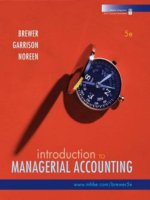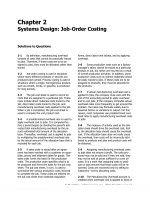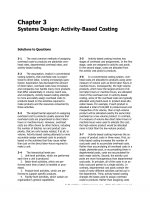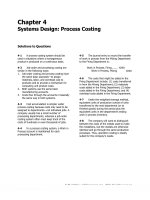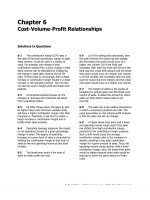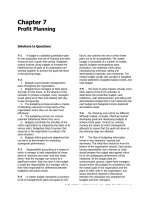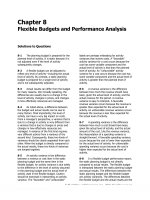Solution manual introduction managerial accounting 5e by garrison chapter 04
Bạn đang xem bản rút gọn của tài liệu. Xem và tải ngay bản đầy đủ của tài liệu tại đây (697.8 KB, 29 trang )
To download more slides, ebook, solutions and test bank, visit
Chapter 4
Systems Design: Process Costing
Solutions to Questions
4-1
A process costing system should be
used in situations where a homogeneous
product is produced on a continuous basis.
4-2
Job-order and processing costing are
similar in the following ways:
1. Job-order costing and process costing have
the same basic purposes—to assign
materials, labor, and overhead cost to
products and to provide a mechanism for
computing unit product costs.
2. Both systems use the same basic
manufacturing accounts.
3. Costs flow through the accounts in basically
the same way in both systems.
4-3
Cost accumulation is simpler under
process costing because costs only need to be
assigned to departments—not individual jobs. A
company usually has a small number of
processing departments, whereas a job-order
costing system often must keep track of the
costs of hundreds or even thousands of jobs.
4-4
In a process costing system, a Work in
Process account is maintained for each
processing department.
4-5
The journal entry to record the transfer
of work in process from the Mixing Department
to the Firing Department is:
Work in Process, Firing ......................................
XXXX
Work in Process, Mixing ..............................
XXXX
4-6
The costs that might be added in the
Firing Department include: (1) costs transferred
in from the Mixing Department; (2) materials
costs added in the Firing Department; (3) labor
costs added in the Firing Department; and (4)
overhead costs added in the Firing Department.
4-7
Under the weighted-average method,
equivalent units of production consist of units
transferred to the next department (or to
finished goods) during the period plus the
equivalent units in the department’s ending
work in process inventory.
4-8
The company will want to distinguish
between the costs of the metals used to make
the medallions, but the medals are otherwise
identical and go through the same production
processes. Thus, operation costing is ideally
suited for the company’s needs.
© The McGraw-Hill Companies, Inc., 2010. All rights reserved.
Solutions Manual, Chapter 4
151
To download more slides, ebook, solutions and test bank, visit
Brief Exercise 4-1 (20 minutes)
a. To record issuing raw materials for use in production:
Work in Process—Molding Department .........
23,000
Work in Process—Firing Department.............
8,000
Raw Materials .......................................
31,000
b. To record direct labor costs incurred:
Work in Process—Molding Department .........
Work in Process—Firing Department.............
Wages Payable .....................................
12,000
7,000
19,000
c. To record applying manufacturing overhead:
Work in Process—Molding Department .........
Work in Process—Firing Department.............
Manufacturing Overhead .......................
25,000
37,000
d. To record transfer of unfired, molded bricks from the Molding
Department to the Firing Department:
Work in Process—Firing Department.............
57,000
Work in Process—Molding Department ...
62,000
57,000
e. To record transfer of finished bricks from the Firing Department to the
finished bricks warehouse:
Finished Goods............................................
103,000
Work in Process—Firing Department ......
103,000
f. To record cost of goods sold:
Cost of Goods Sold ......................................
Finished Goods .....................................
101,000
101,000
© The McGraw-Hill Companies, Inc., 2010. All rights reserved.
152
Introduction to Managerial Accounting, 5th Edition
To download more slides, ebook, solutions and test bank, visit
Brief Exercise 4-2 (10 minutes)
Weighted-Average Method
Units transferred out ......................
Work in process, ending:
15,000 units × 80% ....................
15,000 units × 40% ....................
Equivalent units of production ........
Equivalent Units (EU)
Materials Conversion
190,000
12,000
202,000
190,000
6,000
196,000
© The McGraw-Hill Companies, Inc., 2010. All rights reserved.
Solutions Manual, Chapter 4
153
To download more slides, ebook, solutions and test bank, visit
Brief Exercise 4-3 (10 minutes)
Weighted-Average Method
1.
Cost of beginning work in process
inventory...................................
Cost added during the period ........
Total cost (a) ...............................
Materials
Labor
$ 18,000
238,900
$256,900
$ 5,500
80,300
$85,800
$ 27,500
401,500
$429,000
35,000
$7.34
33,000
$2.60
33,000
$13.00
Equivalent units of production (b) .
Cost per equivalent unit (a) ÷ (b) .
2.
Cost per equivalent unit for materials .....
Cost per equivalent unit for labor ...........
Cost per equivalent unit for overhead .....
Total cost per equivalent unit .................
Overhead
$ 7.34
2.60
13.00
$22.94
© The McGraw-Hill Companies, Inc., 2010. All rights reserved.
154
Introduction to Managerial Accounting, 5th Edition
To download more slides, ebook, solutions and test bank, visit
Brief Exercise 4-4 (10 minutes)
Ending work in process inventory:
Materials Conversion
Equivalent units of production ......
Cost per equivalent unit ...............
Cost of ending work in process
inventory ................................
2,000
$13.86
800
$4.43
$27,720
$3,544
Total
$31,264
Units completed and transferred out:
Units transferred to the next
department .............................
20,100
Cost per equivalent unit ...............
$13.86
Cost of units transferred out ......... $278,586
20,100
$4.43
$89,043 $367,629
© The McGraw-Hill Companies, Inc., 2010. All rights reserved.
Solutions Manual, Chapter 4
155
To download more slides, ebook, solutions and test bank, visit
Brief Exercise 4-5 (10 minutes)
Baking Department
Cost Reconciliation
Costs to be accounted for:
Cost of beginning work in process inventory .
Costs added to production during the period .
Total cost to be accounted for ......................
$ 3,570
43,120
$46,690
Costs accounted for as follows:
Cost of ending work in process inventory ......
Cost of units completed and transferred out..
Total cost accounted for...............................
$ 2,860
43,830 *
$46,690
*The cost of units completed and transferred out can be deduced as
follows:
Cost of beginning
Costs added
Cost of ending
Cost of units
work in process + to production = work in process + completed and
inventory
during the period
inventory
transferred out
Cost of units
$3,570 + $43,120 = $2,860 + completed and
transferred out
Cost of units
completed and = $3,570 + $43,120 - $2,860
transferred out
Cost of units
completed and = $43,830
transferred out
© The McGraw-Hill Companies, Inc., 2010. All rights reserved.
156
Introduction to Managerial Accounting, 5th Edition
To download more slides, ebook, solutions and test bank, visit
Exercise 4-6 (10 minutes)
Work in Process—Cooking ............
Raw Materials Inventory .........
42,000
Work in Process—Cooking ............
Work in Process—Molding ............
Wages Payable .......................
50,000
36,000
Work in Process—Cooking ............
Work in Process—Molding ............
Manufacturing Overhead .........
75,000
45,000
Work in Process—Molding ............
Work in Process—Cooking .......
160,000
Finished Goods ............................
Work in Process—Molding .......
240,000
42,000
86,000
120,000
160,000
240,000
© The McGraw-Hill Companies, Inc., 2010. All rights reserved.
Solutions Manual, Chapter 4
157
To download more slides, ebook, solutions and test bank, visit
Exercise 4-7 (10 minutes)
Weighted-Average Method
1.
Work in process, June 1 ..........................................
Started into production during the month .................
Total tons in process ...............................................
Deduct work in process, June 30 ..............................
Completed and transferred out during the month ......
2.
Units transferred out ................................
Work in process, ending:
Materials: 30,000 tons × 60% complete .
Labor and overhead:
30,000 tons × 40% complete ..............
Equivalent units of production...................
Tons of Pulp
20,000
190,000
210,000
30,000
180,000
Equivalent Units (EU)
Labor and
Materials Overhead
180,000
180,000
18,000
198,000
12,000
192,000
© The McGraw-Hill Companies, Inc., 2010. All rights reserved.
158
Introduction to Managerial Accounting, 5th Edition
To download more slides, ebook, solutions and test bank, visit
Exercise 4-8 (15 minutes)
Weighted-Average Method
1.
Units transferred to the next
department ......................................
Work in process, ending:
Materials:
8,000 units × 75% complete ..........
Labor and overhead:
8,000 units × 50% complete ..........
Equivalent units of production .............
Materials
2.
Materials
Cost of beginning work in process ....
Cost added during the period ...........
Total cost (a) ..................................
Equivalent units of production (b) ....
Cost per equivalent unit (a) ÷ (b).....
42,000
Labor
Overhead
42,000
42,000
4,000
46,000
4,000
46,000
6,000
48,000
Labor
$ 4,320
52,800
$57,120
$ 1,040
21,500
$22,540
48,000
$1.19
46,000
$0.49
Overhead
$ 1,790
32,250
$34,040
46,000
$0.74
© The McGraw-Hill Companies, Inc., 2010. All rights reserved.
Solutions Manual, Chapter 4
159
To download more slides, ebook, solutions and test bank, visit
Exercise 4-9 (30 minutes)
Weighted-Average Method
1.
Units transferred to the next production
department .................................................
Ending work in process:
Materials: 10,000 units × 100% complete .....
Conversion: 10,000 units × 30% complete ....
Equivalent units of production .........................
2.
Cost of beginning work in process ..................
Cost added during the period .........................
Total cost (a) ................................................
Equivalent units of production (b)...................
Cost per equivalent unit (a) ÷ (b) ...................
3.
Ending work in process inventory:
Equivalent units of production
(see above) ........................
Cost per equivalent unit (see
above) ...............................
Cost of ending work in process
inventory ............................
Materials Conversion
175,000
10,000
185,000
175,000
3,000
178,000
Materials Conversion
$ 1,500 $ 4,000
54,000
352,000
$55,500 $356,000
185,000
178,000
$0.30
$2.00
Materials Conversion
10,000
3,000
$0.30
$2.00
$3,000
$6,000
Total
$9,000
Units completed and transferred out:
Units transferred to the next
department ........................
Cost per equivalent unit
(see above) ........................
Cost of units completed and
transferred out ...................
175,000
175,000
$0.30
$2.00
$52,500
$350,000
$402,500
© The McGraw-Hill Companies, Inc., 2010. All rights reserved.
160
Introduction to Managerial Accounting, 5th Edition
To download more slides, ebook, solutions and test bank, visit
Exercise 4-10 (30 minutes)
Weighted-Average Method
1. Equivalent units of production
Transferred to next department........................
Ending work in process:
Pulping: 8,000 units x 100% complete ...........
Conversion: 8,000 units x 25% complete ........
Equivalent units of production ..........................
2. Cost per equivalent unit
Cost of beginning work in process ................
Cost added during the period .......................
Total cost (a) ..............................................
Equivalent units of production (b) ................
Cost per equivalent unit, (a) ÷ (b) ...............
Pulping
Conversion
157,000
157,000
8,000
2,000
159,000
165,000
Pulping
$ 4,800
102,450
$107,250
165,000
$0.65
Conversion
$
500
31,300
$31,800
159,000
$0.20
3. Cost of ending work in process inventory and units transferred out
Pulping
Ending work in process inventory:
Equivalent units of production...
8,000
Cost per equivalent unit ...........
$0.65
Cost of ending work in process
inventory ...............................
$5,200
Units completed and transferred out:
Units transferred to the next
department ...........................
157,000
Cost per equivalent unit ...........
$0.65
Cost of units completed and
transferred out....................... $102,050
Conversion
Total
2,000
$0.20
$400
$5,600
157,000
$0.20
$31,400
$133,450
© The McGraw-Hill Companies, Inc., 2010. All rights reserved.
Solutions Manual, Chapter 4
161
To download more slides, ebook, solutions and test bank, visit
Exercise 4-10 (continued)
4. Cost reconciliation
Costs to be accounted for:
Cost of beginning work in process inventory
($4,800 + $500) ........................................
Costs added to production during the period
($102,450 + $31,300) ................................
Total cost to be accounted for .......................
Costs accounted for as follows:
Cost of ending work in process inventory ......
Cost of units completed and transferred out ..
Total cost accounted for ...............................
$ 5,300
133,750
$139,050
$ 5,600
133,450
$139,050
© The McGraw-Hill Companies, Inc., 2010. All rights reserved.
162
Introduction to Managerial Accounting, 5th Edition
To download more slides, ebook, solutions and test bank, visit
Exercise 4-11 (20 minutes)
Weighted-Average Method
1. Computation of equivalent units in ending inventory:
Units in ending inventory ..........
Percent completed ...................
Equivalent units of production ...
Materials
3,000
80%
2,400
Labor
3,000
60%
1,800
Overhead
3,000
60%
1,800
2. Cost of ending work in process inventory and units transferred out:
Materials
Ending work in process inventory:
Equivalent units of
production .................
2,400
Cost per equivalent unit
$12.50
Cost of ending work in
process inventory .......
$30,000
Labor
Overhead
1,800
$3.20
1,800
$6.40
$5,760
$11,520
Units completed and transferred out:
Units transferred to the
next department .........
25,000 25,000
Cost per equivalent unit
$12.50
$3.20
Cost of units completed
and transferred out ..... $312,500 $80,000
25,000
$6.40
$160,000
Total
$47,280
$552,500
3. Cost reconciliation:
Total cost to be accounted for ...........................
Costs accounted for as follows:
Cost of ending work in process inventory ......
Cost of units completed and transferred out ..
Total cost accounted for ...............................
$599,780
$ 47,280
552,500
$599,780
© The McGraw-Hill Companies, Inc., 2010. All rights reserved.
Solutions Manual, Chapter 4
163
To download more slides, ebook, solutions and test bank, visit
Exercise 4-12 (10 minutes)
Weighted-Average Method
Pounds transferred to the Packing Department
during July* ......................................................
Work in process, July 31:
Materials: 25,000 pounds × 100% complete .......
Labor and overhead:
25,000 pounds × 60% complete......................
Equivalent units of production ..............................
Labor &
Materials Overhead
375,000
375,000
25,000
400,000
15,000
390,000
* 20,000 + 380,000 – 25,000 = 375,000
© The McGraw-Hill Companies, Inc., 2010. All rights reserved.
164
Introduction to Managerial Accounting, 5th Edition
To download more slides, ebook, solutions and test bank, visit
Problem 4-13A (45 minutes)
Weighted-Average Method
1. Equivalent units of production:
Transferred to next department........................
Ending work in process:
Materials: 40,000 units x 100% complete .......
Conversion: 40,000 units x 25% complete ......
Equivalent units of production ..........................
2. Cost per Equivalent Unit
Cost of beginning work in process ................
Cost added during the period .......................
Total cost (a) ..............................................
Equivalent units of production (b) ................
Cost per equivalent unit, (a) ÷ (b) ...............
3. Applying costs to units:
Materials Conversion
160,000
40,000
200,000
10,000
170,000
Materials Conversion
$ 25,200
334,800
$360,000
200,000
$1.80
Materials Conversion
Ending work in process inventory:
Equivalent units of production
40,000
Cost per equivalent unit .......
$1.80
Cost of ending work in process
inventory ...........................
$72,000
Units completed and transferred out:
Units transferred to the next
department .......................
160,000
Cost per equivalent unit .......
$1.80
Cost of units completed and
transferred out...................
$288,000
160,000
$ 24,800
238,700
$263,500
170,000
$1.55
Total
10,000
$1.55
$15,500
$87,500
160,000
$1.55
$248,000
$536,000
© The McGraw-Hill Companies, Inc., 2010. All rights reserved.
Solutions Manual, Chapter 4
165
To download more slides, ebook, solutions and test bank, visit
Problem 4-13A (continued)
4. Cost reconciliation:
Costs to be accounted for:
Cost of beginning work in process inventory
($25,200 + $24,800) ..................................
Costs added to production during the period
($334,800 + $238,700) ..............................
Total cost to be accounted for .......................
Costs accounted for as follows:
Cost of ending work in process inventory ......
Cost of units completed and transferred out ..
Total cost accounted for ...............................
$ 50,000
573,500
$623,500
$ 87,500
536,000
$623,500
© The McGraw-Hill Companies, Inc., 2010. All rights reserved.
166
Introduction to Managerial Accounting, 5th Edition
To download more slides, ebook, solutions and test bank, visit
Problem 4-14A (45 minutes)
Weighted-Average Method
1. Equivalent units of production
Transferred to next department* ......................
Ending work in process:
Materials: 15,000 units x 60% complete .........
Conversion: 15,000 units x 20% complete ......
Equivalent units of production ..........................
Materials Conversion
95,000
9,000
104,000
95,000
3,000
98,000
*Units transferred to the next department = Units in beginning work in
process + Units started into production − Units in ending work in
process = 10,000 + 100,000 − 15,000 = 95,000
2. Cost per equivalent unit
Cost of beginning work in process ................
Cost added during the period .......................
Total cost (a) ..............................................
Equivalent units of production (b) ................
Cost per equivalent unit, (a) ÷ (b) ...............
Materials Conversion
$ 1,500
154,500
$156,000
104,000
$1.50
$ 7,200
90,800
$98,000
98,000
$1.00
3. Cost of ending work in process inventory and units transferred out
Materials Conversion
Ending work in process inventory:
Equivalent units of production...
9,000
Cost per equivalent unit ...........
$1.50
Cost of ending work in process
inventory ...............................
$13,500
Units completed and transferred out:
Units transferred to the next
department ...........................
95,000
Cost per equivalent unit ...........
$1.50
Cost of units completed and
transferred out....................... $142,500
Total
3,000
$1.00
$3,000
$16,500
95,000
$1.00
$95,000
$237,500
© The McGraw-Hill Companies, Inc., 2010. All rights reserved.
Solutions Manual, Chapter 4
167
To download more slides, ebook, solutions and test bank, visit
Problem 4-14A (continued)
4. Cost Reconciliation
Costs to be accounted for:
Cost of beginning work in process inventory
($1,500 + $7,200) .....................................
Costs added to production during the period
($154,500 + $90,800) ................................
Total cost to be accounted for .......................
Costs accounted for as follows:
Cost of ending work in process inventory ......
Cost of units completed and transferred out ..
Total cost accounted for ...............................
$ 8,700
245,300
$254,000
$ 16,500
237,500
$254,000
© The McGraw-Hill Companies, Inc., 2010. All rights reserved.
168
Introduction to Managerial Accounting, 5th Edition
To download more slides, ebook, solutions and test bank, visit
Problem 4-15A (60 minutes)
Weighted-Average Method
1. Computation of equivalent units in ending inventory:
Units transferred to the next department ........
Ending work in process:
Mixing: 1 unit × 100% complete ................
Materials: 1 unit × 80% complete ..............
Conversion: 1 unit × 70% complete ...........
Equivalent units of production ........................
Mixing
Materials
50.0
50.0
1.0
0.8
51.0
50.8
Conversion
50.0
0.7
50.7
2. Costs per equivalent unit:
Cost of beginning work in process inventory ....
Cost added during the period .........................
Total cost ......................................................
Equivalent units of production ........................
Cost per equivalent unit .................................
Mixing
$ 1,670
81,460
$83,130
51.0
$1,630
Materials
$ 90
6,006
$6,096
50.8
$120
Conversion
$ 605
42,490
$43,095
50.7
$850
© The McGraw-Hill Companies, Inc., 2010. All rights reserved.
Solutions Manual, Chapter 4
169
To download more slides, ebook, solutions and test bank, visit
Problem 4-15A (continued)
3. Costs of ending work in process inventory and units transferred out:
Ending work in process inventory:
Equivalent units of production ....................
Cost per equivalent unit.............................
Cost of ending work in process inventory....
Units completed and transferred out:
Units transferred to the next department ....
Cost per equivalent unit.............................
Cost of units transferred out ......................
Mixing
Materials
Conversion
Total
1.0
$1,630
$1,630
0.8
$120
$96
0.7
$850
$595
$2,321
50.0
$1,630
$81,500
50.0
$120
$6,000
50.0
$850
$42,500
$130,000
4. Cost reconciliation:
Cost to be accounted for:
Cost of beginning work in process inventory
($1,670 + $90 + $605) ..............................
Cost added to production during the period
($81,460 + $6,006 + $42,490)...................
Total cost to be accounted for ......................
Costs accounted for as follows:
Cost of ending work in process inventory ......
Cost of units transferred out.........................
Total cost accounted for ...............................
$ 2,365
129,956
$132,321
$ 2,321
130,000
$132,321
© The McGraw-Hill Companies, Inc., 2010. All rights reserved.
170
Introduction to Managerial Accounting, 5th Edition
To download more slides, ebook, solutions and test bank, visit
Problem 4-16A (45 minutes)
Weighted-Average Method
1. Equivalent units of production
Transferred to next department........................
Ending work in process:
Materials: 40,000 units x 75% complete .........
Conversion: 40,000 units x 60% complete ......
Equivalent units of production ..........................
2. Cost per equivalent unit
Cost of beginning work in process ................
Cost added during the period .......................
Total cost (a) ..............................................
Equivalent units of production (b) ................
Cost per equivalent unit, (a) ÷ (b) ...............
Materials Conversion
190,000
30,000
220,000
190,000
24,000
214,000
Materials Conversion
$ 67,800
579,000
$646,800
220,000
$2.94
$ 30,200
248,000
$278,200
214,000
$1.30
3. Total units transferred .................................
190,000
Less units in the beginning inventory............
30,000
Units started and completed during April ......
160,000
Note: This answer assumes that the units in the beginning inventory are
completed before any other units are completed.
4. No, the manager should not be rewarded for good cost control. The
Mixing Department’s low unit cost for April occurred because the costs
of the prior month have been averaged in with April’s costs. This is a
major criticism of the weighted-average method. Costs computed for
product costing purposes should not be used to evaluate cost control or
to measure performance for the current period.
© The McGraw-Hill Companies, Inc., 2010. All rights reserved.
Solutions Manual, Chapter 4
171
To download more slides, ebook, solutions and test bank, visit
Problem 4-17A (45 minutes)
Weighted-Average Method
1. Equivalent units of production
Transferred to next department* ......................
Ending work in process:
Materials: 15,000 units x 100% complete .......
Conversion: 15,000 units x 60% complete ......
Equivalent units of production ..........................
Materials Conversion
170,000
15,000
185,000
170,000
9,000
179,000
*Units transferred to the next department = Units in beginning work in
process + Units started into production − Units in ending work in
process = 18,000 + 167,000 − 15,000 = 170,000
2. Cost per equivalent unit
Cost of beginning work in process ................
Cost added during the period .......................
Total cost (a) ..............................................
Equivalent units of production (b) ................
Cost per equivalent unit, (a) ÷ (b) ...............
Materials Conversion
$ 14,600
133,400
$148,000
185,000
$0.80
$ 7,200
225,500
$232,700
179,000
$1.30
3. Cost of ending work in process inventory and units transferred out
Materials Conversion
Ending work in process inventory:
Equivalent units of production...
15,000
Cost per equivalent unit ...........
$0.80
Cost of ending work in process
inventory ...............................
$12,000
Units completed and transferred out:
Units transferred to the next
department ...........................
170,000
Cost per equivalent unit ...........
$0.80
Cost of units completed and
transferred out....................... $136,000
Total
9,000
$1.30
$11,700
$23,700
170,000
$1.30
$221,000
$357,000
© The McGraw-Hill Companies, Inc., 2010. All rights reserved.
172
Introduction to Managerial Accounting, 5th Edition
To download more slides, ebook, solutions and test bank, visit
Problem 4-18A (45 minutes)
Weighted-Average Method
1. a. Work in Process—Refining Department.........
Work in Process—Blending Department ........
Raw Materials ........................................
495,000
115,000
b. Work in Process—Refining Department.........
Work in Process—Blending Department ........
Salaries and Wages Payable ...................
72,000
18,000
c. Manufacturing Overhead .............................
Accounts Payable ...................................
225,000
d. Work in Process—Refining Department.........
Manufacturing Overhead ........................
181,000
d. Work in Process—Blending Department ........
Manufacturing Overhead ........................
42,000
e. Work in Process—Blending Department ........
Work in Process—Refining Department ...
740,000
f. Finished Goods ...........................................
Work in Process—Blending Department ...
950,000
610,000
90,000
225,000
181,000
42,000
740,000
950,000
g. Accounts Receivable .................................... 1,500,000
Sales .....................................................
1,500,000
Cost of Goods Sold ......................................
Finished Goods ......................................
900,000
900,000
© The McGraw-Hill Companies, Inc., 2010. All rights reserved.
Solutions Manual, Chapter 4
173
To download more slides, ebook, solutions and test bank, visit
Problem 4-18A (continued)
2.
(g)
Accounts Receivable
1,500,000
Bal.
Bal.
Raw Materials
618,000 (a)
610,000
8,000
Bal.
(a)
(b)
(d)
Bal.
Work in Process
Refining Department
38,000 (e)
740,000
495,000
72,000
181,000
46,000
Work in Process
Blending Department
Bal.
65,000 (f)
950,000
(a)
115,000
(b)
18,000
(d)
42,000
(e)
740,000
Bal.
30,000
Bal.
(f)
Bal.
Finished Goods
20,000 (g)
900,000
950,000
70,000
Manufacturing Overhead
(c)
225,000 (d)
223,000
Bal.
2,000
Accounts Payable
(c)
225,000
Salaries and Wages Payable
(b)
90,000
Sales
(g)
1,500,000
(g)
Cost of Goods Sold
900,000
© The McGraw-Hill Companies, Inc., 2010. All rights reserved.
174
Introduction to Managerial Accounting, 5th Edition
To download more slides, ebook, solutions and test bank, visit
Analytical Thinking (45 minutes)
Weighted-Average Method
1. The revised computations follow:
Equivalent Units of Production:
Transferred to finished goods ...................................
Ending work in process:
Transferred in costs: 600 units x 100% complete ....
Materials: 600 units x 0% complete .......................
Conversion: 600 units x 35% complete...................
Equivalent units of production ..................................
Cost per Equivalent Unit:
Cost of beginning work in process ............................
Cost added during the period ...................................
Total cost (a) ..........................................................
Equivalent units of production (b) ............................
Cost per equivalent unit, (a) ÷ (b) ...........................
Transferred
In Costs
Materials Conversion
1,800
600
1,800
0
2,400
1,800
Transferred
In Costs
Materials
$ 4,068
17,940
$22,008
2,400
$9.17
$1,980
6,210
$8,190
1,800
$4.55
1,800
210
2,010
Conversion
$ 2,160
13,920
$16,080
2,010
$8.00
© The McGraw-Hill Companies, Inc., 2010. All rights reserved.
Solutions Manual, Chapter 4
175
